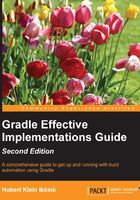
What this book covers
Chapter 1, Starting with Gradle, introduces Gradle and how to install it. We will write our first Gradle script and discuss command-line and GUI features of Gradle.
Chapter 2, Creating Gradle Build Scripts, looks at tasks as part of the Gradle build scripts. We will see how to define tasks and how to use task dependencies to describe the build logic.
Chapter 3, Working with Gradle Build Scripts, covers more functionalities that we can apply in Gradle scripts. We will discuss how to work with files and directories, apply logging to our build scripts, and use properties to parameterize our build scripts.
Chapter 4, Using Gradle for Java Projects, discusses all about using the Java plugin for Gradle projects. Gradle offers several tasks and configuration convention that makes working with Java project very easy. We see how to customize the configuration for project that cannot follow the conventions.
Chapter 5, Dependency Management, covers the support for dependencies by Gradle. We will discuss how to use configurations to organize dependencies. We will also see how to use repositories with dependencies in our build scripts.
Chapter 6, Testing, Building, and Publishing Artifacts, introduces the support of Gradle to run tests from the build script. We will discuss how to build several artifacts for a project and how to publish the artifacts to a repository so that other developers can reuse our code.
Chapter 7, Multi-project Builds, covers Gradle's support for multi-project builds. With Gradle, we can configure multiple projects that can be related to each other easily. We will also see how Gradle can automatically build related or dependent projects if necessary.
Chapter 8, Mixed Languages, explains the Scala and Groovy plugin that is included with Gradle to work with projects that have Scala or Groovy code.
Chapter 9, Maintaining Code Quality, introduces the code quality plugins of Gradle. We will see how to use and configure the plugins to include code analysis in our build process.
Chapter 10, Writing Custom Tasks and Plugins, introduces what we need to do to write our own custom task and plugins. We will see how to decouple the definition and usage of a custom task and plugin in separate source files. We will also discuss how to reuse our custom task and plugin in other projects.
Chapter 11, Gradle in the Enterprise, introduces the support of several continuous integration tools for Gradle. We will discuss how to configure a continuous integration server to automatically invoke our Gradle build scripts.
Chapter 12, IDE Support, looks at how Gradle can generate project files for Eclipse and IntelliJ IDEA. We will also see how the IDEs support Gradle from within the IDE in order to run, for example, tasks and keep track of dependencies defined in Gradle scripts.